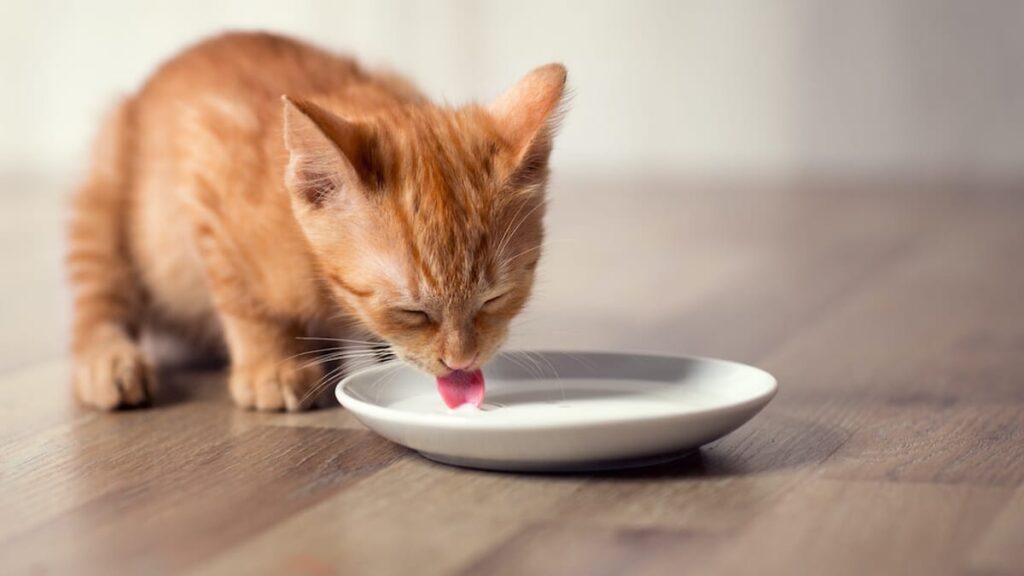Discovering the best milk for cats.
© Lucky Business / Shutterstock
Posted on
Milk shouldn’t be part of your cat’s meal. It is simply a treat that you give your feline to make him happy.
Are you going to change your roommate’s eating habits? This is the best way to avoid digestive problems and stomach upsets.
Go straight to cat milk and low in lactose. If you need it to feed the little ones, choose the specific formula, which contains all the nutrients necessary for their growth.
You can find the right formula online, but also at your vet and in pharmacies. Check out the buying guide we have prepared with all the information about cat milk.
Your furball will already be licking his chops!
Why give milk to the cat?
It all depends on the cat. If he is not weaned, giving him milk is essential for his survival. The special milk for kittens is a balanced food which helps the animal to grow.
An adult cat, on the other hand, doesn’t need to drink milk to be healthy. This drink becomes a pleasure. In this case, giving him some is a way to please the animal, in order to strengthen your bond.
If Kitty loves milk, you can offer him some to tame and reassure him when he enters your home.
Can giving milk to a cat be dangerous?
Milk is not dangerous for cats who are not allergic to it. However, 50% of small breed adults are intolerant or allergic to lactose or the proteins it contains.
This is why you need to be very careful when you give milk to your cat. If he doesn’t tolerate it, he will suffer from digestive problems, skin rashes, diarrhea and itching. Allergy to lactose or milk proteins can also cause bilateral ear infections.
If your cat tolerates milk, you can give it in small quantities without problems. But be careful, milk must remain a food to be given occasionally and should not be part of your pet’s daily diet! Milk contains fat and your pet’s diet would become too rich.
Not all dairy products are good for cats. You can give your cat some yogurt if he doesn’t have allergies. However, avoid cream and cheeses which could cause health problems.
How much milk for cats?
Do not exceed 10ml of milk per kilo of body weight. So if your cat weighs 3 kg, it should drink no more than 30 ml of milk per day.
If you are feeding a kitten breast milk, you should give it three to eight meals a day, depending on age. For the first week, 13 ml should be given per day, and 17 ml for the second week. From the age of 3 weeksincrease the dose to 20 ml and then to 22 ml in the fourth week.
Please note this is an average. To find out how much formula to give a kitten, especially look at the doses indicated on the box.
How long do cats drink milk?
If you are feeding an unweaned kitten, milk will be given up to eight weeks of age. Like all small mammals, even kittens need milk suited to their needs to grow and strengthen.
Starting at three or four weeks, you can start introducing some solid food for a varied diet.
When the cat reaches ten weeks of age, there are two possibilities: either it becomes intolerant to milk proteins or it continues to digest them without problems. In the first case, you have to stop giving him milk. In the second case, it is possible to give them from time to time.
What is cat milk?
If you have to bottle feed a kitten, don’t give it cow’s milk, which can make it sick and doesn’t contain all the nutrients it needs to grow. The kitten would quickly develop deficiencies! Opt for one special milk for kittenspacked with all the vitamins a little one needs.
Once an adult, if your cat is not allergic or intolerant to lactose, you can give him milk in small quantities. If your cat is lactose intolerant or cannot tolerate milk proteins, you can give him lactose-free milk.
The latter is specially formulated for adult felines and is enriched with lactase, which makes it easier to digest.
To find out if your cat is lactose intolerant, add a few drops of milk to his water. If it develops diarrhoea, vomiting or loose stools, it means that your pet is one of the 50% of dogs that are allergic or intolerant.

